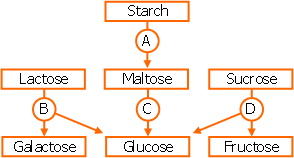NEET Digestion and Absorption Questions | Digestion and Absorption Class 11 NEET Questions | Solve this free online test now | MCQs Test no. 05(b)
Digestive system and Nutrition: Quiz - 5(b)
Question 1 |
intestinal glands | |
endocrine glands | |
gastric glands | |
Salivary glands |
Question 2 |
Liver cells | |
Endothelial cells (cells lining the blood vessels) | |
Macula densa cells | |
Juxtaglomerular (JG) cells |
Question 3 |
Retinol – Xerophthalmia | |
Ascorbic acid – Scurvy | |
Calciferol – Pellagra | |
Cobalamin – Beri-beri |
Question 4 |
Water and mineral salts | |
Amino acids and glucose | |
Glucose and vitamins | |
Fatty acids and glycerol |
Question 5 |
urine laden with ketone bodies | |
kidney stones | |
vitamin A toxicity | |
hypercholesterolemia |
Question 6 |
Hepatopancreatic duct | |
Common bile duct | |
Pancreatic duct | |
Cystic duct |
Question 7 |
Processes and stores nutrients | |
Involved in blood glucose homeostasis | |
Produces bile for emulsification of fats | |
Secrete hormone called gastric |
Question 8 |
pyloric sphincter | |
sphincter of Oddi | |
ileocecal (ileocaecal) valve | |
gastric-oesophageal sphincter |
Question 9 |
| List I | List II | ||
| (a) | Salivary amylase | (i) | Proteins |
| (b) | Bile salts | (ii) | Milk proteins |
| (c) | Renin | (iii) | Starch |
| (d) | Pepsin | (iv) | Lipids |
| (e) | Steapsin | (v) | Emulsification of fats |
a – v, b – iv, c – i, d – ii, e – iii | |
a – ii, b – iii, c – iv, d – v, e – i | |
a – ii, b – iv, c – iii, d – I, e – v | |
a – iii, b – v, c – ii, d – i, e – iv |
Question 10 |
| Column I | Column II | ||
| (i) | Goblet cells | (a) | Antibacterial agent |
| (ii) | Lysozyme | (b) | Mucus |
| (iii) | Saliva | (c) | HCl |
| (iv) | Oxyntic cells | (d) | Sublingual gland |
i – a, ii – c, iii – d, iv – b | |
i – b, ii – c, iii – a, iv – d | |
i – d, ii – a, iii – b, iv – c | |
i – b, ii – a, iii – d, iv – c |
Question 11 |
Read the statements A and B.
A) The human small intestine is the longest portion in the alimentary canal
B) Absorption of digested food requires a very large surface area
Identify the correct choice on the two statements.
Statements A and B are both correct. | |
Statement A is correct, B is wrong. | |
Statement B is correct, A is wrong. | |
Both the statements are wrong. |
Question 12 |
Oxyntic cells — A secretion with pH between 2.0 and 3.0 | |
Alpha cells of islets of Langerhans — Secretion that decreases blood sugar level | |
Kupffer cells — A digestive enzyme that hydrolyses nucleic acids | |
Sebaceous glands — A secretion that evaporates for cooling |
Question 13 |
| Column - I (Types of cells) | Column — II (Secretions) | ||
| (A) | Beta cells | (p) | Lysozyme |
| (B) | Mast cells | (q) | Mucus |
| (C) | Paneth cells | (r) | Histamine |
| (D) | Acinar cells | (s) | Insulin |
| (t) | Pancreatic enzymes |
A – s, B – r, C – p, D – t | |
A – q, B – r, C – p, D – t | |
A – s, B – q, C – p, D – t | |
A – t, B – q, C – r, D – s |
Question 14 |
Consider the following statements:
(A) Niacin (the anti-pellagra vitamin) is present in meats, fish, peanuts, poultry, fruits and leafy green vegetables.
(B) Crypts of Lieberkuhn are present in the liver
(C) Steapsin is the pancreatic amylase
A and C correct | |
A and C incorrect | |
B and C correct | |
B and C incorrect |
Question 15 |

A = Amylase, B = Maltase, C = Lactase, D = Invertase | |
A = Amylase, B = Maltase, C = Invertase, D = Lactase | |
A = Amylase, B = Invertase, C = Maltase, I) = Lactase | |
A = Amylase, B = Lactase, C = Maltase, D = Invertase |
Browse this website for more of NEET Biology Questions (MCQS) | There is a huge NEET Biology Question Bank with chapter wise NEET Biology questions



thank you, you’re making me comfortable for my next exams
i really appreciate the way they are helping the students by giving questions on net.
da above questions are wonderful.
Arent crypts of lieberkuhn present in duodenum only? Please check que-14.thanks! 🙂
crypts are present throughout small intestine
nice questions